Crew 261 EVA Report 10-05-2023
EVA # 15
Author: James Burk (Commander)
Purpose of EVA: Exploration of Candor Chasma + Drone Flights to Capture Outreach Footage
Start time: 8:27 AM
End time: 10:55 AM
Narrative:
Overview of EVA
This EVA was one that Commander Burk has been looking forward to since his last mission, that of Crew 197 in Oct 2018. On Sol 5 of that mission (which was the last day of a 1 week special mission for the MarsVR project), the crew visited Candor Chasma using a now-undrivable route to the southern ridge. It was his favorite EVA of that mission because of the huge landforms on both sides of Candor and the spectacular views. He was eager to return to that location. Our crew’s EVA-10 was meant to return to that area, but was the wrong destination, because Commander Burk was given the mistaken impression (during conversations external to our crew & our mission) that in 2018 he had gone to Sommerville Overlook and not the southern ridge of Candor during that EVA. So, today was finally the day for him to visit that area again.
Our primary objective was to capture drone footage for the purposes of public Education & Outreach, especially for XO Aline Decadi’s work on behalf of the European Space Agency. We selected the crew for this EVA with that in mind — Crew Engineer Julian Villa-Massone for his expertise with drones and piloting, Commander Burk for his past (albeit limited) knowledge of the Candor area and also his skill to fly drones, and XO Decadi to direct the two drone pilots on what footage would work well for her E&O needs. Our HSO, Audrey Derobertmasure, was included to keep an eye out for any irrational exuberance on the part of the drone pilots (who, it needs to be pointed out, have both temporarily lost a drone already during this mission!). She would also have the responsibility of ensuring that everybody stayed hydrated and had frequent health checks.
Another objective was to continue testing of the ADAPA drone, as the spectacular scenery would be an asset for drone footage for the ADAPA team.
The crew selected Spirit and Perseverance for the mission with the rationale that it was a medium-distance EVA (ie, shorter than Lith Canyon or Sea of Shells) and it would be a good test of those two rovers to make the destination.
The crew set out with the goal of returning by 11AM to provide GreenHab Officer Cecile Renaud (who was acting as HabComm for this EVA) the ability to be able to return to her many experiment duties remaining for the mission.
Our target was to enter the floor of Candor on foot from the rover parking area on Galileo Road that is due southwest of Compass Rock (which we had previously used for EVA-7 and EVA-10) so that we could fly the drones down the middle of the geological complex, but we knew that would be hard to find and possibly unwalkable, so either the northern or southern ridges on the western part of the feature would also have worked.
We set out in both rovers, with Commander Burk and HSO Derobertmasure in the lead rover, Spirit, and XO Decadi and Crew Engineer Villa-Massone in Perseverance. We noticed that both rovers drained battery much quicker than the other pair we have, and Perseverance rapidly dropped into the 60s even before we made the turn to Galileo Road. It was not clear during the outbound traverse if we would be able to reach the destination, and Crew Engineer Villa-Massone reminded everybody of the SOC limitations and the potential need to abort, just after we made the turn to Galileo Road. However, the crew did make it to our “rover parking spot” southeast of Galileo Road without incident.
For this EVA we had a lot of gear to carry — four water bottles, three drones, a VR drone headset, and other accessories like spare batteries. We ended up using a small wooden box that was carried in tandem by Crew Engineer Villa-Massone and XO Decadi, who have similar height. The EVA team headed due southeast on foot from the rovers, carrying the gear, and looked for the entrance to Candor’s floor.
We walked a bit across the sandy scrub-grass terrain, with Commander Burk reminding everybody to watch out for Martian reptiles, and eventually found an overlook just southeast of Compass Rock which had a lots of fine-grained sand, which strongly resembled the Florida Gulf Coast beaches that Commander Burk frequented in his earlier days. He even placed his water bottle on the sand and rotated it to dig it into the sand, as he used to in Florida. It was a transient and happy connection that, for him, set the tone for the rest of the EVA.
Crew Engineer Villa-Massone set up the Adapa 360 drone for another (final) test flight. We were hopeful that the camera issue we experienced during the last EVA would resolve itself. He flew the drone for a few minutes along the length of the stretch of Candor we were near, and returned it to check the camera. It again had shut off, likely at the moment of takeoff due to a power spike (our leading theory). He attempted one more quick flight and the same thing happened with the camera cutting out shortly upon liftoff, so we moved on.
Commander Burk then launched his DJI Mavic Air 2 drone and made several passes over Candor, the EVA team’s position, and other landform elements nearby. Crew Engineer Villa-Massone also launched his DJI Mini 2 and did the same. HSO Derobertmasure commented “Drone Race!” as the two continued to work their video-capturing drones across and along the landforms. At one point, Commander Burk flew the drone close to the EVA team’s position using a downward sideways maneuver which made HSO Derobertmasure flinch, an outcome he had not intended and he quickly apologized to her. But the team was in good spirits and waved at the drones as the flew past, also taking photos of the landscape and themselves in different groupings.
After the two drones had returned, the EVA team discussed what to do next, as the primary objective seemed to be completed. They were mindful of the time, and wanting to return to ensure that their hard-working colleague GreenHab Officer Renaud would have enough time to finish her tasks in the GreenHab and Science Dome. The EVA team ultimately decided to continue exploring Candor on foot, to not fly any more drones, and to return to the rovers in 20 minutes, ensuring they would be back on campus by 11AM.
The team packed up their gear, and walked in a south-southwesterly direction along the northern ridge of Candor. They found another overlook approx. 200-300m from their previous position, which was almost directly south of Compass Rock. They took more photos and gathered some rocks and headed back to the rovers. They returned to the Hab without incident.
During the entire EVA, all crew members reported health at 5 and were in an exhilarated mood.
Issues Experienced During EVA 7
- Adapa Drone did not record footage despite two attempts. Given the time available and environmental conditions, in depth troubleshooting was not possible. After a quick troubleshooting, we have determined that the issue was not fixable on site but a more thorough testing at the base would be required to exhaust all options. The issue is that the camera does not record videos after takeoff and loses power.
Outcomes
- It is easy to reach the south side of Candor by continuing down south on the spur of Galileo Road (or it might be Watney Road??) after the “turn” at Compass Rock (I say “turn” because it is not a definable turn at all due to the washed out terrain south of Compass Rock). That southern spur is well-defined and well-traveled once you leave the washed out area.
- Perseverance barely made it to our destination before getting to SOC 60 which would have required an abort. I could see it easily not making it. I feel it is risky for us to use Perseverance for any EVA that is not within the immediate vicinity of the Hab and maybe 2 km radius.
- Spirit certainly has a lower battery capacity than Oppy and Curiosity, but it was able to do the whole mission today (including return trip) and stay well above 60.
Destination: Candor Chasma
Coordinates (use UTM WSG 84): 521500 E, 4251000 N
EVA Participants: 4: James Burk (Commander) (EVA Lead), Aline Decadi (XO), Julien Villa-Massone (Crew Engineer), Audrey Derobertmasure (HSO).
Road(s) and routes per MDRS Map: Drive to Cow Dung Road, then North to Galileo Road, then East/SouthEast to Compass Rock. Walk on foot to explore area.
Mode of travel: Spirit and Perseverance
Crew 261 EVA Report 05-06-2023
EVA # 16
Author: Erin Kennedy (Crew Roboticist)
Purpose of EVA:
1) Human-Robot Interaction experiment with Atmosphinder robot to activate functions based on coloured card sequences as detected with embedded computer vision
2) Autonomous sensor-based function activation with the anemometer and sails
3) Additional sail testing
Start time: 3:20 PM
End time: 4:10 PM
Narrative:
Overview of EVA
The half-sized Atmosphinder robot with electronics and sails was tested today. The objectives of the test were surrounding human-robot interaction while fully suited in astronaut gear. This comprised of two smaller tests: 1) autonomous function activation based on anemometer wind speed and 2) computer vision with coloured card sequences. The new code for these tests was integrated with the existing environmental sensor data logging code.
1) Autonomous sensor-based function activation with the anemometer
Two autonomous wind sensor functions were tested. The two functions varied in their granularity of thresholds of wind speed. The first test was successful, as controlled by the wind, without manual intervention, transitioning through each state correctly. To evaluate the performance of each of these tests, visual checks to the LEDs mounted on the robot were performed, as their patterns and colours correspond to the different states that control the sail trim servos.
The second test worked for transitioning through 6 out of 8 thresholds without manual intervention. The last two thresholds were possible to reach with manual intervention, though the sail frame rotational issue was impeding the result, given those thresholds required more wind speed to meet. Additionally, a LED strip indicator was added to display the relative wind speed. This was also used to reference the performance of the wind tests with the gusts of wind.
Overall, the result from the first wind test proved that Atmosphinder was able to change its functions from the wind sensor, as shown by the LEDs. In combination with controlling the sail trim servos, this is an indicator that in the future, controlling the direction of the robot based on the current winds will be possible.
2) Human-Robot Interaction experiment to activate functions based on coloured card sequences
The computer vision colour card sequence test was not guaranteed to work as designed given the lighting conditions differed from when it was initially trained. Initial training was conducted on a sunny day, whereas today’s conditions were overcast and cloudy.
Two functions for the computer vision were tested. The first would move the sails to set positions. The second would move the sails in synchronised or opposite directions. Both use the same colour sequence detection.
The pink and green colour combination sequence was tested on both tests, and the camera was able to detect them! As with the wind function testing, the LEDs were used to observe the state of the servo movements. The orange and green colour combination was tested at a larger angle. With the cards positioned properly, the camera was able to detect it!
Conclusion
Delays to the EVA start time were encountered due to technical development and repair work that extended beyond the initial estimated time. This was communicated to some of the crew over messaging. The window of time for the EVA was still met, allowing testing to be performed outside in the relevant environment, which was valuable. The testing documentation created alongside the technical development greatly assisted during the EVA testing to serve as an evaluation guideline.
The EVA was aborted early due to inclimate weather conditions approaching. A debrief was conducted with the crew. It was helpful to hear their point of view in order to form a balanced perspective of the activity given Atmosphinder’s technical results from today’s testing. Extracting learning lessons from the entire crew’s experience was invaluable.
Appendix: Additional technical issues encountered:
– An error was encountered where once the combination was detected, the state would not exit. This resulted in needing to press the test button multiple times to arrive back at the computer vision testing mode.
– The variable to set the production vs development version was not set (#define OUTDOORS false). Resulting in the LEDs being dimmer, and slightly lower latency due to printf debugging statements.
– The lighting conditions differed from those that were used for training. Training would need to be done outdoors, where it was difficult to view the computer screen.
– The embedded computer vision camera tracks colour signatures, which are sensitive to different lighting conditions. A better approach would have been to track AR markers, also known as AprilTags. For an embedded solution, the OpenMV camera would be a better choice than the Pixy 1 camera (https://openmv.io/blogs/news/apriltag-marker-tracking-the-future-is-here). However, the decision to use Pixy 1 embedded computer vision camera was solely based on the fact that we had it available and had used it previously.
– Sail frame rotation about the axis parallel to the hoops. This rotation occurs over time, and with large gusts of wind. An attempt to solve with cord was unsuccessful. This issue has been presented in prior EVAs yet remains unsolved.
– The servo related problem noticed on a previous EVA appeared again on today’s EVA, meaning the problem was not resolved entirely. This will be checked again.
– ‘Party mode’ in the state machine did not activate due an off by one error of the total count of the number of states in the state machine (party mode being the final state)
Issues Experienced During EVA-16
[Procedural] The pre EVA Atmosphinder Field Test checklist was not followed, thereby the RAM garage door was locked, which required a crew member to unlock it (while maintaining Sim).
[Communications] Not everyone was kept up to date regarding time delays, as they were communicated over messaging. Next time the yellow radio will be used instead.
[Technical] A crew member in the observatory was not aware we had aborted the mission. They called on the black radio, since we were supposed to be on EVA, however the engineering airlock was locked, and she couldn’t get back in. Next time the yellow radio on Ch 1 from downstairs will be brought.
Outcomes
1) The result from the first wind test proved that Atmosphinder was able to change its functions from the wind sensor. This is an indicator that in the future, controlling the direction of the robot based on the current winds will be possible.
2) Colour cards were easily used by the astronaut to show to the robot’s camera. The robot’s camera was able to detect, and perform functions based on it.
3) ‘Party mode’ included in the state machine ended up saving computer vision test #2, as this state would have been unreachable otherwise due to the off-by-one error
4) Gaining invaluable learning lessons from the experience of crew members during the debrief
Destination:
In front of the Hab (4250900 N, 518100 E)
Coordinates (use UTM WGS 84): See above
EVA Participants: 4: Cecile Renaud (EVA Leader), Julian Villa-Massone (Crew Engineer), Erin Kennedy (Crew Roboticist), Kris Davidson (Journalist) (Not In Sim – Not Wearing Suit)
Road(s) and routes per MDRS Map: In front of the Hab
Mode of travel: Walking
Vehicles you will be using (If applicable): N/A


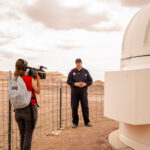
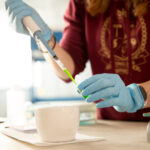
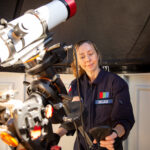
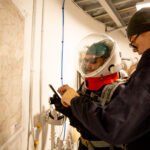
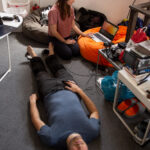
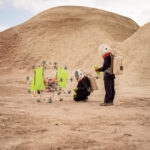

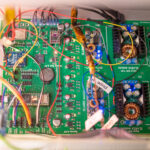
You must be logged in to post a comment.